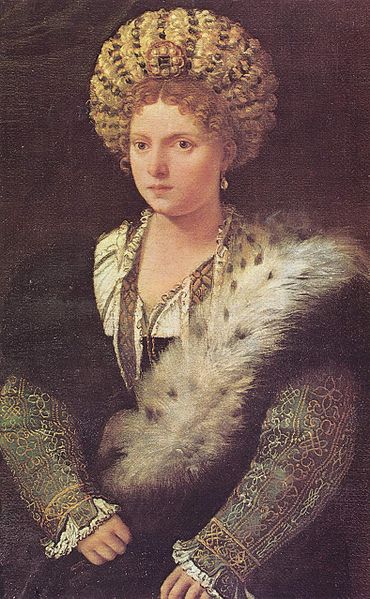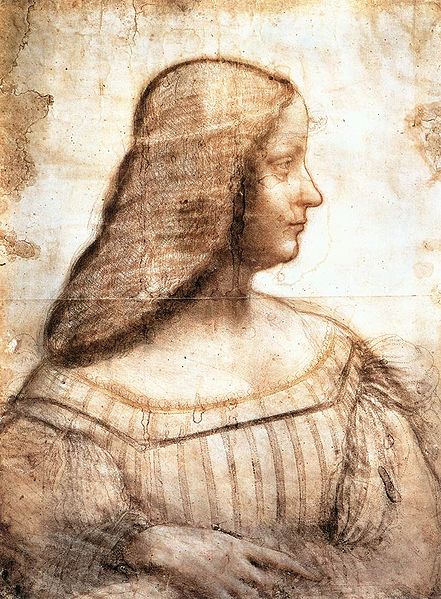<Back to Index>
- Mathematician, Philosopher and Poet Omar Khayyám, 1048
- Painter Jan Pieter Veth, 1864
- Marchesa of Mantua Isabella d'Este, 1474
PAGE SPONSOR


Isabella d'Este (May 18, 1474 – February 13, 1539) was Marchesa of Mantua and one of the leading women of the Italian Renaissance as a major cultural and political figure. She was the regent of Mantua during the absence of her husband, Francesco II Gonzaga, Marquess of Mantua, and the minority of her son, Federico, Duke of Mantua.
Isabella was born on May 18, 1474 in Ferrara, to the Duke Ercole and Duchess Leonora of Ferrara. Leonora was the daughter of Ferdinand I of Naples, the Aragonese King of Naples, and Isabella of Taranto.
Isabella was received with great joy, although a son had been hoped
for. One year later on 29 June 1475 her sister Beatrice d'Este was
born. Then in 1476 and 1477 two brothers were born. The first was
Alfonso and second Ippolitto. In 1479 and 1480 two more brothers were
born; they were Ferrante and Sigismondo. Of all the children Isabella
reigned as the favourite. In
1479, when Ferrante was born, Isabella travelled to Naples with her
mother. When her mother returned to Ferrara, Isabella went with her,
while the other children stayed with their grandfather for eight years.
On her voyage with her mother, Isabella acquired the art of politics. In
her youth, Isabella received a good education. As a child she studied
Roman history, and rapidly learned to translate Greek and Latin (the
former would become her favourite language). Because of her outstanding
intellect, she often discussed the classics and the affairs of state
with ambassadors. Moreover, she knew the painters, musicians, writers,
and scholars, who lived in and around the court. Besides her knowledge
of history and languages, she could also recite Virgil and Terrence by
heart. Isabella was also a talented singer and musician, and was taught
to play the lute by Giovanni Angelo Testagrossa. In addition to all these admirable accomplishments, she also was an innovator of new dances. In
1480, at the age of six, Isabella was betrothed to Francesco Gonzaga,
the heir to the Marquis of Mantua. Although he was not handsome,
Isabella admired him for his strength and bravery; she also regarded
him as a gentleman. After their first few encounters, she found that
she enjoyed his company and spent the next few years getting to know
him and preparing herself to be the Marchesa of Mantua. During their
courtship, Isabella treasured the letters, poems, and sonnets he sent
her as gifts. Ten years later, at age 16, she married Francesco Gonzaga,
who had by then succeeded to the marquisate. Isabella became his wife
and Marchesa amid a spectacular outpouring of popular acclamation.
Besides Marquis, Francesco was also Captain General of the armies of the Republic of Venice.
Because of his many duties, a couple of days after their honeymoon he
left her to perform her responsibilities on her own. Isabella
was not abandoned: she spent time with her mother and sister, and upon
meeting Elisabetta Gonzaga, her 18 year old sister-in-law, the two
women became fast and warm friends. Isabella D'Este and Francesco Gonzaga had 8 children.
Isabella
played an important role in Mantua during their time of need. When her
husband was captured in 1509 and held hostage in Venice, she took
control of Mantua's military forces and held off their invaders until
his return in 1512. While ruling, she appeared to have been much more
aggressive than her husband. Therefore, upon his return he realized
that he'd been humiliated and became angry with her, allowing her to
travel and live glamorously until his death of disease in 1519. After the death of her husband, Isabella ruled Mantua as regent for her son, Federico.
She began to play an important role in Italian politics, steadily
advancing Mantua's position. She played a role in promoting Mantua to a
Duchy, which was obtained by wise political use of her son's marriage
contracts, and also obtaining a cardinalate for her son Ercole. She also showed great diplomatic and political skill in her negotiations with Cesare Borgia, who had dispossessed Guidobaldo da Montefeltro, duke of Urbino, the husband of her sister-in-law and good friend Elisabetta Gonzaga (1502).
To
keep herself entertained, she read and played the lute, and soon wanted
to try all the new instruments that were being made available. In
addition to playing music she collected art, and sponsored painters,
such as Titian, Raphael and Da Vinci.
Being a leader of fashion, she bought the finest clothing, including
furs as well as the newest distillations of perfume. However, her role
as a Marchesa required her serious attention, so she decided to learn
the problems faced by a ruler of a city-state. To improve the
well-being of her people she studied architecture, agriculture, and
industry, and followed the principles that Niccolò Machiavelli had set forth for rulers in his book The Prince.
In 1527, Isabella left Mantua for Rome after having been involved in a conflict with her son. She was present during the Sack of Rome (1527),
when her house became an asylum for about 2000 people fleeing the
Imperial soldiers. Her house was one of the very few which was not
attacked, due to the fact that her son was a member of the conquering
army. When she left, she managed to acquire safe passage for all the
refugees which had sought refuge in her house. After conflicts died
down she left Rome, and in her 60's returned to Mantua and made it a
cultural centre, started a school for girls and created her ducal
apartments into a museum of the finest art. Nevertheless this was not
enough for Isabella so she continued her life long quest and ruled a
tiny part of Romagna, Solarolo, until her death on 13 February 1539.